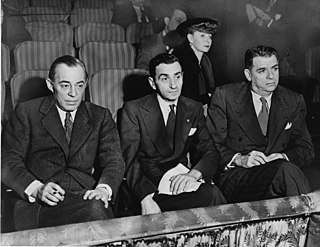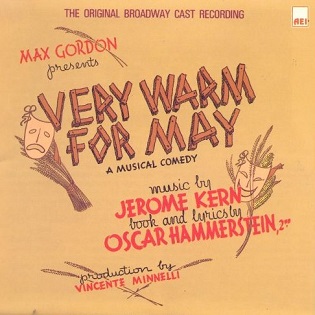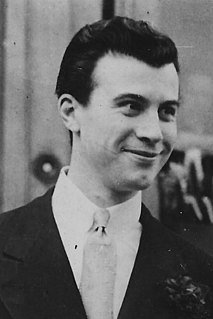History
Origin
The concept musical can be recognized as an extension of the growing concern for the cohesiveness of a particular production: "Unlike Rodgers and Hammerstein or Lerner and Loewe, who simply found a good story and musicalized it, now it was considered appropriate (and artistically more satisfying) to have a vision of the whole show." [7] Leonard Bernstein was a key figure in this movement, with his shows Candide and West Side Story representing a "radical experiment in book writing" in which the book is controlled by theme and metaphor. [4]
The concept musical's non-linear structure and focus on theme are suggestive of the works of Bertolt Brecht. [8] A similar connection can be made to the Living Newspapers of the 1930s. [5] The Broadway production of Lady in the Dark , written by Kurt Weill, Ira Gershwin, and Moss Hart, is considered by some to be a predecessor of the modern concept musical. Its attention to characters and their psychological makeup, rather than the plot and its through-line, foreshadow the concept musical's priority of personal expression. Following Lady in the Dark and throughout the course of his career, Weill favored ideas over a linear narrative. [5] [8] Whatever the exact origin, the growing maturation of musical theatre allowed the genre to become "a vehicle for social commentary and experimentation in form," with the concept musical at the forefront of this movement. [1]
First concept musical
There are two major contenders for the title of first concept musical, although the term itself had yet to be invented: Allegro (1947) by Rodgers and Hammerstein, and Love Life (1948) by Weill and Lerner. [8]
Allegro, which concerns a son following in his father's footsteps, represents a "musical experiment" conducted by Rodgers and Hammerstein. Defying "virtually all musical theatre conventions" of the time, its Greek chorus frequently interrupts the narrative, and the show focuses on a larger theme of personal struggle in the face of success. [9] Minimalist in its staging, patterns of light were used to represent both spaces and emotions. However, many critics disagree as to Allegro's status as a concept musical, stating that the linear nature of the plot continues regardless of the choral interludes. [1] The show was a critical failure, which many theatre historians blame on the inexperience of director-choreographer Agnes de Mille. Disheartened, Rodgers and Hammerstein returned to a more traditional format. [9] Whether or not it was indeed a concept musical or merely a predecessor of things to come, Allegro "opened the door to a splendid new way of writing for musical theatre." [10] Allegro also provides a connection between the concept musical and Stephen Sondheim, who was mentored by Hammerstein and worked as a production assistant on Allegro. [1]
Love Life, the story of a marriage lasting over a century, "disregarded the traditional use of time, interrupted its action with jolting vaudeville numbers that commented on the story, and... tried to illustrate sociological ideas by paralleling them to a long-term personal relationship." [8] Freed from his usual partnership with Loewe, Lerner's growing experimentation with the genre is represented in Love Life. Like Allegro, Love Life's narrative is not explicitly linear, exploring the theme of marriage through a variety of lenses. Sondheim has stated that Love Life was "a useful influence on my own work, but it failed because it started out with an idea rather than a character." [9] [11]
Development
1960s
Concept musicals began to emerge as a significant form in the early 1960s. Their fragmented approach to storytelling helped to revitalize musical theatre as a genre, which was becoming formulaic.[ citation needed ] 1961 saw the premiere of The Fantasticks and Stop the World – I Want to Get Off . In 1965, Man of La Mancha premiered at the Goodspeed Opera House, eventually transferring to Broadway. The "antithesis of what people expected musicals to be," it was nonetheless popular, and marked a growing undercurrent of rebellion against the traditional musical theatre model. [12]
Cabaret premiered on Broadway in 1966, directed by Harold Prince, whose impact "on the concept musical is significant, and he can be considered the primary director who contributed to its creation." [1] The show features songs that comment on the action within the narrative frame of the musical's Kit Kat Klub setting. Removed from the story, these songs serve as commentary in the style of Brecht and Weill's The Threepenny Opera .[ citation needed ]
One of the first rock musicals, Hair , opened Off-Broadway at The Public Theater in 1967 and then on Broadway in 1968. Representative of a communal 1960s "happening," it effectively "provided 'safe' exposure to the counterculture for middle-class audiences." [13]
1970s
"The concept musical truly arrived with Company , a musical that managed to be palatable to audiences even as it broke just about every rule of musical comedy." [8] The 1970 show, with music and lyrics by Sondheim and a book by George Furth, focuses on Bobby, a single man living in New York City on the eve of his thirty-fifth birthday. It examines his romantic and personal relationships with several girlfriends and a variety of his married friends. The success of Company paved the way for more adventurous concept musicals by Sondheim and others. [8]
Director-choreographer Bob Fosse was a key figure in the further development of the concept musical. After directing the film version of Cabaret , Fosse helped to shape the 1972 Broadway musical Pippin , written by Stephen Schwartz and Roger Hirson. [9] Fosse’s conceptual vision for Chicago , which opened on Broadway in 1975, featured vaudeville routines that "comment[ed] on the system of justice and imprisonment in Chicago in the 1920s... Kander and Ebb and Fosse and Prince were advancing upon the convention by which characters have two modes of existence in musicals. They were taking the convention literally, putting show business settings next to 'real' settings... and letting the two overlap." [4]
A Chorus Line marked the first use of the word "conception" in connection with musical theatre. The show, based on interviews with actual dancers, uses the premise of an audition to expose the complex lives of previously-faceless chorus members. [9] Considered by many to be the quintessential concept musical, the popularity of the 1975 New York Shakespeare Festival/Public Theater production and its subsequent Broadway transfer kicked the growing concept musical phenomenon into high gear. [14]
1980s and beyond

Cats , first brought to the stage in 1981, "heralded the dawning of a new postmodern musical era, encapsulating the major difference between the concept musical and the megamusical." Though critics agree that the show is based around a concept rather than a linear plot, author Andrew Lloyd Webber had intended to create a show that was not meant to "reflect [or] comment on the world, even in an oblique, metaphorical way." [6] This was a drastic difference from the metaphors that defined the concept musical. Thus, the concept musical branched out into the megamusical, which utilizes spectacle and increased technology to "radicalize the imagistic potential of musical theatre." [6]
Starlight Express , an "experiment" by Lloyd Webber, debuted on the West End in 1984 and on Broadway in 1987. [10] Like Cats, the show focuses on a central theme rather than a linear plot, with the entire cast on roller skates playing trains. [15] The original concept was to be an "entertainment 'event' for children who love trains." Lloyd Webber has been quoted as saying that the end result was "not quite what we intended," given that the "joy and sense of pure fun that was the original intention seemed to get lost." [10]
Avenue Q , which premiered on Broadway at the John Golden Theatre in 2003, can also be considered a concept musical. Authors Jeff Whitty, Jeff Marx, and Bobby Lopez have spoken of their difficulty categorizing the show: they wanted something that "didn't move like a story," but was not a true revue. Lopez calls it the "hybrid king of revue-slash-show. Using kind of Internet logic. A hyperlink type of logic to go from one subject to another." [16] Its structure is circular, utilizing a series of vignettes and isolated situations to comment on the central idea. The show's theme, like Pippin, focuses on the central character's coming of age search for his purpose. Young-Gerber finds that none of the scenes "bring him closer to discovering his purpose, indicating that the events of the musical will continue after the section shared with the audience is completed." [1]
















